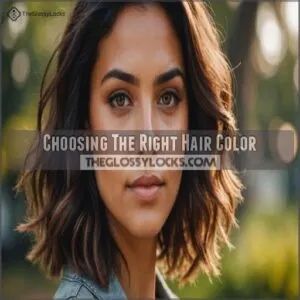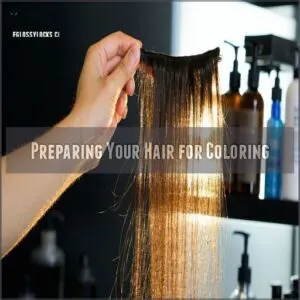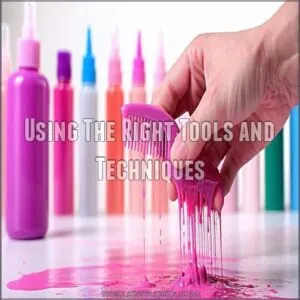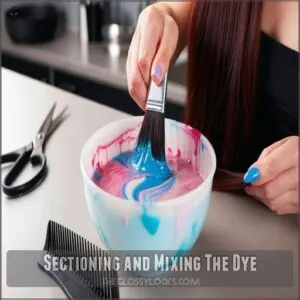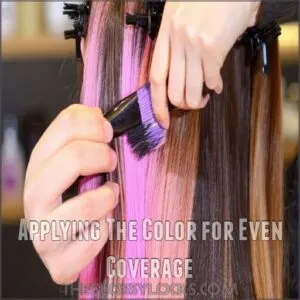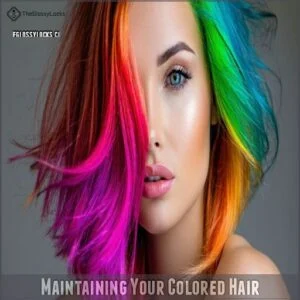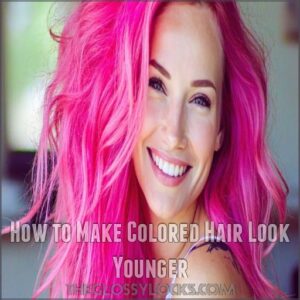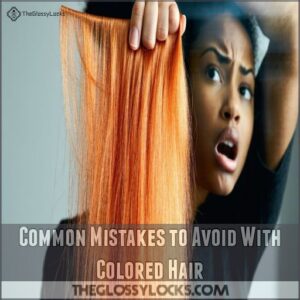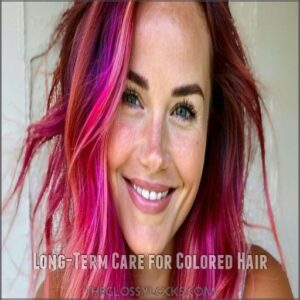This site is supported by our readers. We may earn a commission, at no cost to you, if you purchase through links.

First, choose a shade that complements your skin tone—because no one wants to look like a washed-out mop.
Use a color-safe shampoo and conditioner to keep your color vibrant and avoid over-washing.
And while you’re at it, try a weekly hair mask for that extra boost of shine.
Need a touch-up? Don’t wait until you look like a grown-out skunk.
Curious about how to keep your color looking fresh? Stay tuned for more vibrant tips!
Table Of Contents
- Key Takeaways
- Choosing The Right Hair Color
- Right Hair Color for Your Skin Tone
- Preparing Your Hair for Coloring
- Applying Hair Color Like a Pro
- Maintaining Your Colored Hair
- Tips for Coloring Your Hair at Home
- Choosing The Best Hair Color to Cover Grey
- How to Make Colored Hair Look Younger
- Common Mistakes to Avoid With Colored Hair
- Long-Term Care for Colored Hair
- Frequently Asked Questions (FAQs)
- Can I color my hair at home?
- How do I choose the right hair color?
- How do I maintain my hair color?
- How do you get a better hair color?
- Can You color your hair all over your head?
- What color hair color is right for You?
- What is the most popular hair color?
- What is the best hair Colour to cover grey?
- What hair color makes you look younger?
- How to properly take care of colored hair?
- What not to do with Coloured hair?
- What is the rule in hair coloring?
- What is the aftercare of hair coloring?
- What is the best way to remove hair dye?
- How often should I touch up roots?
- Can I swim after dyeing my hair?
- Will frequent dyeing damage my hair?
- How to protect colored hair from sun damage?
- Conclusion
Key Takeaways
- Pick a hair color that complements your skin tone and eye color for a natural and flattering look.
- Use color-safe shampoos and conditioners to keep your hair vibrant and prevent fading.
- Regularly apply hair masks and conditioners to maintain healthy, hydrated locks after coloring.
- Avoid over-processing and sun exposure to keep your colored hair looking fresh and lively.
Choosing The Right Hair Color
Picking your perfect hair color can feel like finding the right pair of shoes—it’s all about matching with your skin tone, eye color, and personality.
Don’t stress too much about the nuances; think about your natural hair texture and tone, along with the dye formula that complements your unique style.
Consider Skin Tone and Eye Color
Ever wonder why some shades pop on you and others flop? For bold, vibrant hues like Splat Midnight Ruby Red, consider following a thorough preparation process including a skin sensitivity test. Explore the spectrum with these tips for matching hair color to your skin tone and eye color
- Cool tones suit icy blondes and mocha browns.
- Warm tones love butterscotch and honey hues.
- Eye color impacts contrast.
- Brown eyes rock chestnut.
- Blues charm with ash blondes.
Choose shadows wisely!
Consider Hair Texture and Natural Color
Choosing the right hair color isn’t just about picking a shade from a swatch.
Think about your hair’s texture: coarse hair tends to absorb dye quicker, leading to cooler tones, while finer hair might end up warmer.
Your natural color plays a role too in how new shades look, impacting color fade and depth.
Selecting The Right Dye and Formula
Because choosing the right dye is key, let’s talk formulas.
Permanent dyes, with their strong developer, often result in lighter shades than the box promises; use the color swatch for a truer picture.
When looking for hair dye, consider the variety of rose gold shades available to suit different skin tones and hair types, such as rose gold hair color. Check out the wide range of hair dye brands available to find the perfect match for your hair type.
Semipermanent dyes darken over time, so go slightly lighter than your target shade.
Consider your hair texture; coarse hair grabs color faster, giving cooler tones, while fine hair takes longer, leading to warmer hues.
Keep color changes simple—one or two shades max—unless you’re consulting a pro.
Right Hair Color for Your Skin Tone
To nail the perfect hair color, start by knowing your skin tone.
It’s like your personal color wheel, guiding you toward hues that harmonize with your natural undertones.
Imagine your skin tone as your hair’s best friend—always whispering secrets of cool and warm shades.
For those with cool undertones (think blues and pinks), icy blondes and mocha browns can really sparkle.
On the flip side, if your skin has warm undertones (like yellow or gold), colors like honey or chestnut will complement beautifully.
You can determine your skin tone using a skin tone test tool, helping you narrow down your color options.
A skin tone chart is your trusty guide here, helping you navigate through the myriad of choices in the hair color guide.
Don’t just color your hair; make it an extension of who you are.
It’s like wearing the right outfit for your mood—transformative and liberating.
Get ready to embrace that glow-up!
Preparing Your Hair for Coloring
Before you transform your locks into a vibrant masterpiece, make sure your hair is ready for its makeover.
You wouldn’t paint on a dusty old barn door, would you?
Think of it like prepping a canvas.
Pre-Dyeing Hair Preparation
Alright, you’re ready to pick the right hair color.
Before you leap into coloring, let’s get that hair prepped!
Start with a clarifying shampoo to nix any buildup, then embrace hair oil to fend off dryness.
Set your hair wash schedule to clean, not squeaky clean.
Detangling and Sectioning
Before coloring, save yourself a tangle of trouble! With proper detangling and sectioning, you’re halfway to blissful coloring success.
- Detangling tools: Invest in a good wide-tooth comb.
- Sectioning techniques: Split hair into manageable quadrants.
- Preventing tangles: Clip each section firmly, helping the dye’s magic unfold smoothly.
Ready your mane with these sectioning tips!
Protecting The Hairline
Save your hairline from unwanted dye mishaps.
It’s like putting on sunscreen before a beach day—simple yet essential.
To prevent stains and guarantee a smooth coloring process, use a gentle cleanser like Dove Beauty Bar Moisturizing Cleanse in case of accidents, as described in this guide on how to remove hair dye from scalp.
Grab some Vaseline or a barrier cream and create a shield by slicking it around your hairline to prevent those pesky stains.
This little trick is your first line of defense against dye drips and keeps your face fresh and clean.
Applying Hair Color Like a Pro
When it comes to applying hair color like a pro, having the right tools and techniques transforms the process from intimidating to fun.
Imagine you’re not just coloring hair, but crafting art—section wisely, mix accurately, and paint your masterpiece with flair.
Using The Right Tools and Techniques
Ready to express your inner artist? Choosing the right tools makes all the difference. Think of it as prepping your canvas before painting a masterpiece.
Here’s what you need:
- A good application brush for even color distribution.
- A wide-tooth comb for blending highlights seamlessly.
- Gloves to protect your hands from staining.
- A spoolie brush for precise bleach application (if needed).
Following these simple steps will make your at-home color job a breeze!
Sectioning and Mixing The Dye
Once you’ve embraced the idea of dyeing your hair, let’s jump into sectioning and mixing like a pro.
Divide your mane into four parts to keep things neat.
When mixing, follow the dye’s instructions carefully to nail the perfect ratios.
Think of it like baking—except here, precision and patience lead to a vibrant masterpiece that’s distinctly you.
Applying The Color for Even Coverage
For a flawless finish, remember this: neat sectioning is key.
Avoid streaks by using precise application techniques and tools.
Mix the dye thoroughly to guarantee even color.
Here are some tips:
- Clip small sections to manage better.
- Brush from roots to tips for uniformity.
- Wipe excess dye from the skin quickly to keep tidy.
Maintaining Your Colored Hair
To keep your colored hair looking as fresh as the day you left the salon, make friends with color-safe shampoo and limit your sun exposure and heat styling.
Regular touch-ups are like scheduled spa days for your hair—they keep your color vibrant and your roots in check!
Using Color-Safe Shampoo and Conditioner
To keep your hair color popping and vibrant, you’d want to use color-safe shampoo and conditioner.
Think of them as the guardians against color fade, packed with gentle ingredients.
These heroes prevent your hue from washing down the drain.
Brands like Pureology and Olaplex offer great protection, letting your vibrant hair stay lively, without stripping away its spirit.
Limiting Sun Exposure and Heat Styling
Imagine letting your hair bask in the sun, but it’s not all sunshine and rainbows for colored hair!
Protect it with UV-blocking sun protection products and avoid frying it with too much heat styling.
Embrace hair masks and cold styling instead.
Try air drying when possible.
After all, who needs extra heat when you’ve got a sun-kissed look already?
Getting Regular Touch-Ups
Keeping your color vibrant isn’t just about avoiding the sun—it’s about those regular touch-ups.
Think of it as the secret handshake in your hair routine.
To prevent common color issues, such as brassiness or fading, consider learning about hair color correction and maintenance.
- Schedule root touch-ups every 4-6 weeks to combat color fading.
- Decide if salon or home touch-ups fit your lifestyle.
- Invest in maintenance tips to extend your color’s life.
Tips for Coloring Your Hair at Home
Ready to explore your artistic side and try DIY hair coloring?
We’ll guide you through essential tips for achieving salon-worthy results at home, avoiding those common pitfalls that can leave you with less-than-stellar results (like that time I accidentally turned my hair green…don’t ask!).
Performing a Strand Test
Think of a strand test like a sneak peek into your future hair color journey.
Before diving in, it guarantees color accuracy and consistency.
Simply mix a small amount of dye and apply it to a hidden strand.
After the recommended time, you can interpret the results.
It’s a tiny effort offering big insights into how the color adapts to your unique hair.
Following The Directions Carefully
You’ve mastered the strand test, now it’s all about precision with your dyeing adventure. Follow directions like a pro to avoid mishaps. Here’s the scoop:
- Read thoroughly: Misjudge mixing ratios and you’ll face wild colors.
- Time it right: Stick to the dyeing time for best results.
- Stay safe: Wiggle into your gloves and keep splatter chaos at bay!
Avoiding Common Mistakes
No one wants to face a hair coloring mess.
Avoid these common blunders with confidence!
Stay attentive to timing—over-processing hair and unwanted damage aren’t your friends.
Don’t forget to prep your locks by washing and conditioning your hair with a sulfate-free shampoo 24-48 hours before coloring, avoid conditioning hair right before to allow natural oils to return.
Check these reminders:
| Common Mistake | Easy Fix |
|---|---|
| Skipping strand test | Do a small patch first |
| Leaving dye on too long | Set a timer |
| Not reading instructions | Follow carefully |
Dodging pitfalls keeps your hair fierce!
Choosing The Best Hair Color to Cover Grey
Covering gray hair can feel like a challenging task, but choosing the right color makes all the difference.
You’ll want a shade that blends well with your natural hair while adding a hint of highlights or balayage for a fresh, youthful look—think more "Silver Fox" than "Wizarding Geezer."
Considering Your Natural Hair Color
Embracing your natural hair color when covering gray can work wonders for a seamless look.
You should know that understanding your hair’s underlying pigment, like the eumelanin responsible for black and brown hues, is key to choosing a suitable color, as black hair’s unique genetic makeup.
Your natural hue serves as the perfect canvas, offering color inspiration and ensuring compatibility with your skin tone and hair type.
Think of it as enhancing, not masking, your beauty.
This method keeps you on trend while adding freedom to your hair journey.
Selecting The Right Shade and Formula
Picking the right shade and formula is like choosing a partner—get it wrong, and you’re stuck.
Don’t trust the model on the box; instead, check the color swatch for accuracy.
If you want to cover gray, go with a semi-permanent dye, which gives you flexibility.
Consider your hair texture since it affects how dye develops.
Using Highlights or Balayage
Want to subtly cover those pesky grays?
Highlights or balayage might be your secret weapon!
Highlights add pops of color, while balayage offers a more natural, sun-kissed look.
Consider your hair color and skin tone when choosing shades.
For at-home balayage, use a balayage kit and focus on strategic placement.
Regular balayage maintenance keeps your color fresh.
Ready to explore some balayage color ideas?
Let’s dive in!
How to Make Colored Hair Look Younger
If you’re aiming to spruce up your colored hair and knock a few years off your look, consider embracing lighter shades or adding playful highlights to bring out a youthful glow.
Just like a good laugh can be contagious, a deep conditioning treatment or hair mask can work wonders, softening your strands and giving them a fresh, vibrant boost.
Lightening The Hair for a Brighter Look
Shine brighter by lightening your hair!
Choose the right shade and bleach safely to avoid mishaps.
Keep your blonde brilliant by sticking to a regular root touch-up routine.
At-home lightening can be a breeze if you take it slow and steady.
Remember, there’s no rush—you’re on your own time, like savoring your favorite ice cream on a lazy day.
Adding Highlights or Lowlights
Feel like your hair needs a little sparkle? Sprucing up with highlights or lowlights can add dimension and youthful flair. Imagine the subtle highlights catching light like sun on a meadow.
To keep your highlights looking vibrant, consider using color-safe hair products.
Here’s how:
- Focus on face-framing highlights for instant brightness.
- Mix different shades for natural color blending.
- Careful lowlight placement can create depth.
- Ensure color contrast enhances your base hue.
Using Hair Masks and Deep Conditioning
While highlights add depth, hair masks make your color shine.
Imagine your hair as a thirsty garden needing nourishment.
Use DIY hair mask recipes weekly to keep those hues vibrant.
Opt for ingredients like avocado and honey for the best deep conditioning benefits.
Apply evenly, focusing on ends, and watch your locks transform from wilted to wonderful with regular mask frequency.
| Ingredient | Benefit | Frequency |
|---|---|---|
| Avocado | Moisture and shine | Weekly |
| Honey | Smoothness and gloss | Bi-weekly |
| Coconut oil | Deep nourishment | Every 10 days |
| Aloe vera | Hydration and repair | Weekly |
Common Mistakes to Avoid With Colored Hair
When coloring your hair, it’s easy to mess up by over-processing or neglecting regular touch-ups.
These mistakes can leave your hair looking less than fabulous.
Forgetting these simple steps might just have you sporting that surprise Halloween look all year round!
Over-Processing The Hair
That youthful look you’re after can hit a snag if you over-process your hair. Think about these three big no-no’s:
- Hair Breakage and Split Ends: Overdoing it with color can lead to straw-like strands and brittle ends.
- Color Fading Faster: Washing too often or using harsh products can make your vibrant hue disappear overnight.
- Dryness and Damage: Chemicals strip moisture—hello, Sahara! Trust us, a deep conditioner isn’t just a suggestion.
Not Getting Regular Touch-Ups
Over-processing is one thing, but neglecting root regrowth is another common mistake.
Faded color and uneven shades scream "I haven’t touched up my roots in ages!"
Regular touch-ups are key to maintaining vibrant color.
Think of it as a mini-color correction session every few weeks.
A DIY touch-up is simpler than a full color job.
You can easily save money and time with this color maintenance strategy.
Don’t let your roots get too far out of control.
The goal? That fresh-from-the-salon look.
A little upkeep goes a long way in keeping your colored hair looking its best.
Long-Term Care for Colored Hair
Keeping your colored hair vibrant for the long haul involves more than just avoiding shampoo aisle mishaps—it’s about nourishing those locks from the inside out.
Make sure you’re using color-depositing shampoos, protecting your hair from the sun, and munching on foods rich in omega-3s and vitamin E to keep your color as fresh as your favorite meme.
Using a Color-Depositing Shampoo and Toner
After steering clear of over-processing pitfalls, consider using a color-depositing shampoo and toner.
They’re your secret weapon for brassiness control and a vibrant color refresh.
These products enhance your hair health by depositing pigments, keeping your shade rich and your locks looking salon-fresh.
Think of it as giving your hair a spa day without leaving home.
Protecting The Hair From Sun Damage
When the sun’s blazing, your hair’s yearning for shade.
Think of sun-protective hair products as your trusty sidekick; they’re the UV-blocking cape your strands crave.
Weave hats and scarves into your summer style to fend off damage.
Don’t let the sun bleach your vibrancy away—ensure your summer hair care routine is packed with UV-blocking hair treatments.
Eating a Diet Rich in Omega-3 Fatty Acids and Vitamin E
Boosting your diet with Omega-3s and Vitamin E isn’t just a health kick; it’s hair magic!
For healthy hair growth and hair loss prevention, try:
- Food Sources: Try salmon, eggs, and spinach.
- Supplements: Pop a daily fish oil pill if you’re not a fan of seafood.
- Hair Health Benefits: Notice stronger, shinier locks that resist fading!
Frequently Asked Questions (FAQs)
Can I color my hair at home?
Home hair coloring is totally doable. Just remember to do a strand test first. Follow instructions carefully, and you’ll be rocking your new look in no time. Have fun!
How do I choose the right hair color?
When choosing a hair color, it’s essential to consider your skin tone, hair texture, and current hair color, as well as matching skin undertones to the right shade. Over 80% of people choose hair colors online.
If unsure, consult a pro for personalized advice and stunning results.
Opt for shades complementing your skin tone and eye color—icy blonde for cool tones, honey blond for warm.
How do I maintain my hair color?
Using a color deposit shampoo, like purple shampoo for vibrant hair, can help preserve the intensity of your hair color. To maintain vibrant hair color, use a color-safe shampoo and conditioner.
Limit hair washing and sun exposure.
Apply a hydrating mask weekly.
Wait 24 hours before washing after dyeing for rich, long-lasting color.
How do you get a better hair color?
Pick the right dye by matching your skin tone and hair texture.
Always do a strand test first.
Opt for a slightly darker permanent or a lighter semi-permanent dye.
Don’t skip aftercare for longer-lasting results.
Can You color your hair all over your head?
Absolutely, you can color your entire head, but it’s important to think about your natural shade, skin tone, and hair texture.
Use the right dye and follow recommended steps for an even, vibrant color transformation.
What color hair color is right for You?
Figuring out your perfect hair color is like finding the right pair of shoes; it’s all about what fits you best.
Consider your skin tone, eye color, and personal style.
Explore warm or cool tones accordingly!
What is the most popular hair color?
Right now, blondes truly have more fun—platinum and icy blonde shades top the charts!
They’re edgy yet timeless, ideal for anyone craving a fresh look.
Ready to stand out? Embrace this bold, head-turning trend!
What is the best hair Colour to cover grey?
The best color to cover gray depends on your natural shade and skin tone.
Blondes can use highlights or go all-over blonde.
Darker hair might try ash brown or burgundy, which is a variation of the ash hair color characterized by greenish-gray or bluish-gray tones, often associated with a cool, muted, and natural aesthetic, as seen in ash brown hair styles.
Consider a professional for a perfect match!
What hair color makes you look younger?
Channel your inner youth with lighter shades like honey or caramel blonde.
They’re a touch of sunshine and also a cheeky way to hide those grays, adding brightness and a fresh look to your style.
How to properly take care of colored hair?
Keep colored hair vibrant by using color-safe shampoo, deep conditioning weekly, and protecting hair from sun exposure with UV products.
Wait 24 hours post-dye to wash, and avoid over-processing for healthy, stunning locks.
What not to do with Coloured hair?
Don’t skip conditioner; it locks in color.
Avoid washing too soon—wait 24 hours.
Say no to harsh shampoos that strip color.
Steer clear of the sun without protection.
Never leave dye on longer than instructed.
What is the rule in hair coloring?
When dyeing your hair, pick a shade that complements your skin.
Perform a strand test.
Follow instructions closely.
Use quality products.
Care for your hair post-coloring to maintain vibrancy and health.
What is the aftercare of hair coloring?
After coloring your hair, wait 24 hours before washing.
Use color-safe shampoo and conditioner.
Apply a weekly hair mask for hydration.
A deep conditioner enhances vibrancy, keeping your color fresh and lively.
Limit sun exposure.
What is the best way to remove hair dye?
Scrubbing out hair dye is like chasing the elusive last cookie crumb!
Use a clarifying shampoo, which is a gentle method for removing unwanted toner found in how to remove purple toner, and baking soda mix, apply on damp hair, then rinse.
Repeat if needed, but nourish with conditioner to avoid dryness.
How often should I touch up roots?
Root touch-ups depend on your hair’s growth rate. Generally, every 3-6 weeks is ideal. Faster growers might need them sooner; slower growers, later. It’s all about keeping that fresh color!
Can I swim after dyeing my hair?
Hold off on swimming for at least 72 hours after dyeing your hair.
Chlorine and salt can strip the color.
If you can’t resist, wear a swim cap to protect your vibrant new shade.
Will frequent dyeing damage my hair?
Frequent dyeing can definitely do a number on your hair, making it brittle and thirsty.
So, give your locks a break between coloring sessions and treat them to hydrating masks and color-safe products to keep them healthy.
How to protect colored hair from sun damage?
Shield your colored hair from the sun by wearing a hat.
UV protection
These simple steps can help keep your vibrant hues intact, no sweat!
Conclusion
Congrats, you’ve navigated the wild world of colored hair advice without ending up looking like a tie-dyed accident!
Remember, keeping that color vibrant isn’t rocket science.
Choose shades that flatter your skin tone, prep your hair before the dye, and apply it like a pro.
Stick to color-safe products and steer clear of too much sun and heat.
Your locks will stay as vibrant as a rainbow, minus the pot of gold at the end.

